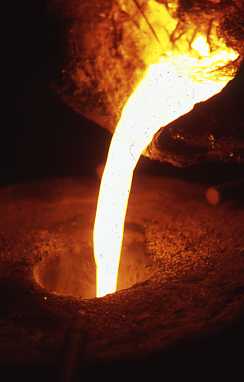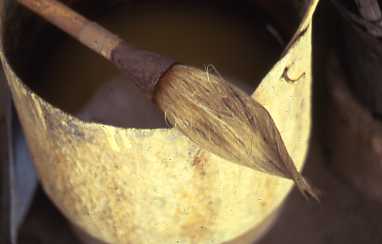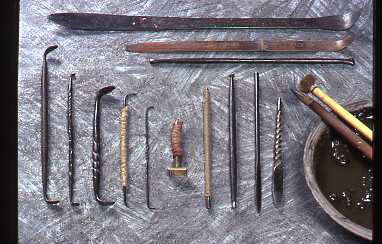山形鋳物の沿革The History of Yamagata Casting
山形鋳物は御令泉天皇の御守、康平年間、源頼義が奥州平定の命を受け、山形地方に転戦の折、従軍した鋳物師が、馬見ヶ崎河原の砂と千歳公園付近の土質が鋳物に適していることを発見し、この地に留まったことにはじまります。
その後、約600年前、延文元年8月斯波兼頼が奥羽大崎より、村山郡山形に入部となり、新たに霞が城を建設しました。この時、斯波兼頼から鋳物御用を申付けられ、鋳物師9名が献納したといわれています。当時、鋳物町は国分寺薬師町の脇にありましたが、慶長年間、最上義光時代には業者数が17となり、御免町として領主の保護を受け、現在の銅町に移されて産地的な形態をとってきました。
山形鋳物は当初、主に日用品、仏具などの小物を中心に生産されました。これらは地場消費のほか、全国的に分布する出羽三山参拝者の土産品に購入されて、次第に各地に広まったといわれています。さらに技術が向上し、梵鐘のような大物も鋳造するようになり梵鐘鋳造の掟状を得るまでに至りました。
山形鋳物は日用品、工芸品を背景として近年に至り、「薄肉美麗」と呼ばれる伝統的な薄肉鋳物製造技術と肌の美しさを定評にして全国的に名声を博してきました。
明治9年に山形県庁が設置され、県産業の振興対策により、山形鋳物の産地活動も活発となり、全国有数の鋳物産地として認められ今日に至りました。
昭和49年4月、わが国の貴重な財産を守る目的で、伝統的工芸品産業振興法が国会で成立しました。山形鋳物は伝統的な手づくりによる技術または技法を用いて製造され、生活に豊かさと潤いを与える製品の優秀さが認められ、国の伝統的工芸品として第一次に指定されています。
(有)鋳心ノ工房
増田尚紀
山形鋳物は当初、主に日用品、仏具などの小物を中心に生産されました。これらは地場消費のほか、全国的に分布する出羽三山参拝者の土産品に購入されて、次第に各地に広まったといわれています。さらに技術が向上し、梵鐘のような大物も鋳造するようになり梵鐘鋳造の掟状を得るまでに至りました。
山形鋳物は日用品、工芸品を背景として近年に至り、「薄肉美麗」と呼ばれる伝統的な薄肉鋳物製造技術と肌の美しさを定評にして全国的に名声を博してきました。
明治9年に山形県庁が設置され、県産業の振興対策により、山形鋳物の産地活動も活発となり、全国有数の鋳物産地として認められ今日に至りました。
昭和49年4月、わが国の貴重な財産を守る目的で、伝統的工芸品産業振興法が国会で成立しました。山形鋳物は伝統的な手づくりによる技術または技法を用いて製造され、生活に豊かさと潤いを与える製品の優秀さが認められ、国の伝統的工芸品として第一次に指定されています。
(有)鋳心ノ工房
増田尚紀
It began in Yamagata 900 years ago during the Kohei Period. Yoriyoshi Minamoto got an order to conquer Oushu (an old part of Yamagata). During their battle in Yamagata, one of their warriors, (who happened to be a casting man) found that the sand along Mamigasaki river and the soil at Chitose Park was perfect for casting; so he decided to stay there.
600 years ago, in the first year of the Enbun Period, Kaneyori Shiba came from Osaki to Murayama in Yamagata. He built a new castle called Ksumiga castle. At that time Kaneyori ordered 9 casting workers to donate many of their casting products to him. The casting town was called Imono, which was next to Kokubunji Yakushii town.
Then came the Keicho Period, the number of casting workers in Imono grew to 17. They received protection from the landlord and were exempt from paying tax. The town was moved North to an area now known as Dou town. It was formed as an industrial town.
Yamagata casting was produced locally and used as a daily commodity and as a Buddhist altar item. Dewsanzans` worshipers and worshipers from all over Japan bought the casting products as souvenirs. Thats how Yamagatas` casting spread to many places around Japan. As casting techniques progressed, more products and larger items were made, such as the main bell of a temple. They strived and got a diploma for producing castings for the bell of Buddhist temples.
Yamagatas` casting continues up to today and is based on everyday commodity and art. It has a winning distinction with a solid reputation of traditional thin casting technique and the beauty of the surface called “Thin Beauty”.
In the Meiji Period year 9 (1876) Yamagata prefectural office was established. They recognized that Yamagatas` casting products was one of the best in all of Japan, so they helped to promote these products. In the Showa Period year 49 (1974) a law for the promotion of traditional industrial arts was passed. Yamagatas` casting is designed as a primary product. It is produced with a traditional handmade skill and technique. It is thought to have other excellent qualities such as enriching our lives with its elegance.
600 years ago, in the first year of the Enbun Period, Kaneyori Shiba came from Osaki to Murayama in Yamagata. He built a new castle called Ksumiga castle. At that time Kaneyori ordered 9 casting workers to donate many of their casting products to him. The casting town was called Imono, which was next to Kokubunji Yakushii town.
Then came the Keicho Period, the number of casting workers in Imono grew to 17. They received protection from the landlord and were exempt from paying tax. The town was moved North to an area now known as Dou town. It was formed as an industrial town.
Yamagata casting was produced locally and used as a daily commodity and as a Buddhist altar item. Dewsanzans` worshipers and worshipers from all over Japan bought the casting products as souvenirs. Thats how Yamagatas` casting spread to many places around Japan. As casting techniques progressed, more products and larger items were made, such as the main bell of a temple. They strived and got a diploma for producing castings for the bell of Buddhist temples.
Yamagatas` casting continues up to today and is based on everyday commodity and art. It has a winning distinction with a solid reputation of traditional thin casting technique and the beauty of the surface called “Thin Beauty”.
In the Meiji Period year 9 (1876) Yamagata prefectural office was established. They recognized that Yamagatas` casting products was one of the best in all of Japan, so they helped to promote these products. In the Showa Period year 49 (1974) a law for the promotion of traditional industrial arts was passed. Yamagatas` casting is designed as a primary product. It is produced with a traditional handmade skill and technique. It is thought to have other excellent qualities such as enriching our lives with its elegance.
[2018.02.14]


